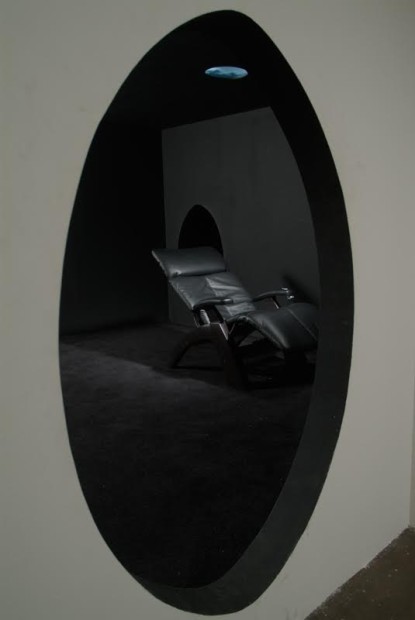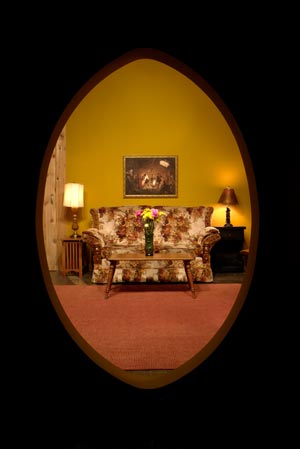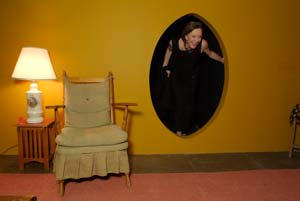On the opening night of Hills Snyder’s new show at Artpace, the exhibition remained closed until after the curator and artists discussed the new work.
During the discussion, Snyder played a song he composed, History Lesson, on his guitar in lieu of a verbal exposition of his work. The lyrics, written under the influence of Snyder’s humor, tickled the song’s blues format with phrases like, “I feel like taking pictures/why don’t you curl up on the bed/I feel like taking pictures/why don’t you curl up on the bed/you don’t have to eat cat food/I’ll open up some tuna instead.” As soon as the panel discussion ended, people lined up outside the show. Only a few viewers were admitted at a time as others waited with piqued interest.
A nail-biting suspense movie can be similarly exhilarating-sitting on the edge of your seat, wondering at the fate of the protagonist, who is spied on, stalked, and chased by the bad guys—yet the experience is passive. Book of the Dead exists as a stage set for viewers to actively engage in the art. We are the protagonists; the show serves as the stage set. My experience beat the very best of thrillers, because through my command performance, I was left like a badly mixed Bond martini—shaken and stirred. Good thing Snyder ended his show with the living room, where viewers mixed and mingled in the midst of domestic comfort and sipped tequila to take the edge off their experience.
Wendy: Your new show at Artpace reminds me of your past show, Son of Samson (Cactus Bra, 2003). In it, there were several miniature vignettes stationed around the room: one was a tiny, doll-house sized living room, while in another, someone had painted themselves into a corner.
You mentioned that you “built” yourself out of the Book of the Dead installation just like Son of Samson‘s man painting himself into a corner. Does the miniature/human scale art in some way represent thought/process?
Hills: In order to answer this question I’ll have to reconstruct that room a bit. The painting-into-a-corner was significant because the painter that should have been trapped by this activity was nowhere to be seen. Opposite the corner where the disappearance took place there was a tiny bed surmounted by several dozen copies of Jerzy Kosinski‘s Being There. This stack of “mattresses” was topped off by one more, a copy of Nabokov’s novel Mary. So you’ve got the figure disappearing from the corner and likewise Mary never appears in Nabokov‘s book. There are also other figures in Son of Samson that are conspicuous by their absence.
Also, one thing about the fiction of Kosinski is that some of his characters inhabit a world strangely filled with invention and emptied of reality. So if you are going to say that art is a lie that tells the truth, you have to also say that sometimes it loses track of the difference.
If we live in a world largely driven by notions of progress, ambition, even greed, you can still hear Dulcinea breathing right next to everything anyway. Therefore, my answer to your question is that the miniature doesn’t represent thought as opposed to process so much as it represents a world that we often ignore that exists inside the one we take for reality. So even though the space at Artpace was my studio for seven weeks it grew smaller on a daily basis as it was replaced by the work itself. In this way, the parallel world of magic and dreams left its imaginary or miniaturized status behind and became fully operational for anybody “real” enough to enter it.
Wendy: When you describe ‘Dulcinea breathing right next to everything anyway,’ it reminds me of being a little girl confounded by my aunt’s dalmation of the same name. I’ve just looked it up and found it to be a Spanish word for ‘elegantly sweet’ as well as the object of one’s hopeless devotion and love. Also, Dulcinea was a character from Cervantes’ Don Quixote, a fictional character whom he imagined being the most beautiful in the entire world, and for whom he was entirely devoted. Do you refer to her as a distraction, or does she represent some inimitable presence within us, something we always reach towards but never grasp? What’s your definition of someone ‘real’ enough to enter?
Hills: I brought up Dulcinea because we were discussing Son of Samson. She or someone like her is the central figure of that narrative. For me her name is evocative of a certain sense of self. She’s an apologist for the idea that identity isn’t entirely a construction—that who we are is a gift that we may discover beneath the layers of the edifice. Everybody knows about her at times, but most of us forget about her too often.
As for being real enough to enter, that’s just my way of saying you should bring her with you. I’ve seen Book of the Dead act much like a mushroom in that it gives you back what you bring to it. Bring assertion or resistance and these qualities will define your experience, while surrender is probably a more productive state. Just a hint: you can’t listen to Dulcinea with a cell phone in your hand.
Wendy: An exotic severity permeates your installation from the very beginning, signaling a transition from the world of cell phones and haircut appointments. We move through the portal which leads viewers into Book of the Dead as if through the eye; through the retina into the mind. In the dark, hushed room, viewers find a tranquil obscurity. At first, the viewer may recline in a plush black leather chair and stare up at a round window showing clouds slowly moving across the sky. Next, viewers move into a space where they may sit in a fluorescent plexi pink electric chair. The word, ‘STAY’ is written on a door facing the viewer, which spurs one to get up and go, and the labyrinth awaits. I’m interested in what compels viewers to move forward, always, instead of just staying. Perhaps it is the intensity of the experience—too rich to devour — that eventually leads us into your living room, yet I feel this urge to progress may be tainted by the external noise, the driving and striving.
Performance often appears in your art — Son of Samson and intoxicating angel,’ dressed in an exquisite white suit holding a tray of hot pink shot glasses filled with tequila for viewers exiting the labyrinth. You wore a pair of mirrored sunglasses which deflected any attempts at conversation. How does your performance work relate to Dulcinea? Is she most with you then? Also, your other art stayed mostly within the spectator/object parameters. Yet this work crosses a boundary. We enter into the spectacle, engage with it, and, in a sense, perform as well.
Hills: This figure we’re calling Dulcinea can be attended to or ignored depending on how mindful anyone might be at any given moment regardless of what they may be doing. I mention the cell phone not to suggest that the every day world must be left behind in order to experience ART, but specifically because a few people ignored the warning posted (For your own protection, you must turn off your cell phone) at the entrance to Book of the Dead and were not seen again except as mere shadows hanging around in the living room as if they’d forgotten something quite important.
I play at being the intoxicating angel just as a reminder that art can take us places if we let it …and please have a smile won’t you? There that’s better now. Drink? Oh, yes and by the way, you are page 175 in the Book of the Dead, I hope you enjoy your stay in the living room… It’s interesting that by being present in that character — whose only interaction is to offer a welcoming drink — I’m virtually absent from the opening itself.
Traditionally, one of my interests has been the psychology of the viewing experience. I tend to create situations that allow participants to miss the piece unless they take the initiative not to. Even the spectator/object stuff, to use your terms, becomes a different experience for the invested viewer than for the casual one. Book of the Dead is an attempt to extend this further in that it was conceived as a space that the viewer must discover in successive stages in order to find their way out of it. A casual walk through isn’t possible. All of this is analogous to that which I’m most interested in: How is it that we can do anything we might be doing and not be there?
Whether or not you are spurred to get up and go is up to you at all times, regardless of the command to STAY. Perhaps even the impulse to define the word as a command to the participant narrows the meaning too far. There may be other interpretations. Maybe what one does in the second chamber is colored by how their time was spent in the first. Some who reclined in the antigravity chair discovered that the round hole in the ceiling as a view to the sky eventually became the defining edge of a blue planet, seen as if from very far away, skies and clouds now become seas and continents. I guess my point is that any “urge to progress” inside the piece can be tempered by the opportunities to linger that the piece offers along the way.
Wendy: Yes, but it can get a bit spooky once someone else comes in—this kind of interior experience is difficult to share in the dark, which is one of the reasons I haven’t lingered much yet. About the chair: “Earth below us, drifting, falling, floating, weightless, calling, calling home.”[1] This old eighties song captures the exhilaration of your ‘antigravity’ chair and the relief of a smile afterwards. On a more shadowy note, is this also the “falling upwards” you describe, the “Chicken Little in reverse” effect of your show in Amsterdam, Steam? Your art does reward the viewer for being present. Really listening to music mirrors really being present. A surrender of attention/self occurs, yet active listening creates more of a coalescing. Your art provides this same kind of enrichment.
Hills: Being with strangers in the dark sharing an experience that is interior in nature… Given the viewers vulnerability, I think the piece does have a severity in the second two chambers. Kind of a Town Without Pity in your brain — something you’ve stumbled into and hope to crawl out of, as if you’ve waked up in the wrong bed; the wrong motel. But it really is necessary to bring the viewer to this precipice so that the fourth chamber, the living room, can be experienced as this wonderfully relieving scene of comfort and familiarity — even though it is tweaked to have the quality of being part of the same nightmare you were in before. Yet you want to stay and dream because the real world waits for you on the other side of the exit door.
I like the idea of answer songs. Eve of Destruction/Dawn of Correction, Wooden Ships/For Everyman, Stand By Your Man/(I’m) A Stand By My Woman Man…etc. I think there might have been one about Harper Valley PTA sung by one of the characters from the original song. Someone should write the prequel.
Somehow I’ve never heard Schilling’s song. But Bowie’s Space Oddity, the song Schilling is answering (or extending as the case may be because in his rejoinder he suggests that Major Tom is still out there), is a song that I’m sure has come up in people’s associations inside the piece. As has the Kubrick film that Bowie’s song gets its title from. Or maybe Schilling was answering Ashes to Ashes, Bowie’s sequel to his own song. Falling upward? — just keep your eyes focused on the planet when you un-recline the chair. Steam is really where Book of the Dead started.
Wendy: At the panel discussion at Artpace, I wasn’t sure how to take your comment about how the sociopath could be a model for the contemporary artist. Sarcasm? Irony? Or just plain strange?
Hills: Irony is a tool — like repetition, craft or the color yellow, it is employed for its various effects, but it is not my stance. Nonetheless, people sometimes attribute their own ironic philosophy or even cynicism to me because the work tends to offer up a mute surface which can work like a mirror for the viewer. The “smiley cross” (not my appellation) is a prime example. Yes it is ironic to superimpose a smiley face on a cross, but the irony is only a device — not my view of life. I’ve been espousing a decidedly un-cynical point of view always — just one example would be my 1987 show Garage Optimism, but you can see it in my work from the early 70s. But the smiley-cross — this image is an expression of unmitigated joy. Mitigation being the hallmark quality of post-modernism—not where I’m coming from — nor is modernism either — I’m arcing over these two avenues even as I occasionally must cross their intersections — I’m reaching back/forward to storytelling and song — which also connects to rural values and 19th century romanticism. And I mean rural more so than just pre-industrial. It’s more of an attitude, a kind of fearlessness or confidence (again unmitigated), such as one might find in a hick who has the courage to order a frozen margarita in the middle of a crowded Manhattan bar populated by cool people and other keypad operators…
The equivocation of the artist with the social worker, tantamount to a form of banishment, the doctrine of the vanishing author (attributed to Foucault and many others)—these murders can only be answered by re-asserting the notion of the artist as a gifted individual that functions in society as a seer (as opposed to healer, public servant, fixer of all ills, etc.). The fact that this is a re-assertion is why the anachronistic romanticized artist must be aligned with the more modern sociopath. In this way the artist can infiltrate/corrupt the mainstream vogue via the door of marginalism, as the sociopath is a marginalized individual. Which gets to the notion of mimicry as espoused by Ted Bundy as the primary attribute of the sociopath who mimics real behaviors because he has none of his own. So the artist must mimic the sociopath in order to disguise his special status as pathology in order to be accepted by the practitioners of the post-modern monolith.
Wendy: Do you mean, then, that through this form of mimicry, the artist realigns the symbols of contemporary society? Or blasphemes them in order to shake up the status quo? The mimicry occurs through the use of the same language, yet the usage is rendered perverse through the ‘pathology.’ An artist who takes up the mantle of a ‘seer’ chooses to share his or her vision. What about this method would cause the practitioners of the post-modern monolith to accept the artist?
Hills: This is just my humor talking. It’s a parody of the notion of an artist needing to have a strategy to gain the notice of influential people as opposed to the idea of just being true to yourself and honest in your work. The art-speak machine loves to talk about marginality, de-centeredness, etc. It’s not that these aren’t serious social issues — they are, but sometimes you get the ideas back from the cleaners with too much starch in them. So I’ve taken the characteristics of the discredited romantic artist and brought them back into play by way of the sociopath because these two types have an interesting and funny parallel alignment: delusions of grandeur, inordinate need for attention, divine inspiration, etc. Plus I just wanted to quote Ted Bundy in the context of an Artpace Dialogue.
But again, this is humor — either you get it or you don’t. When Kinky Friedman sang They Ain’t Makin’ Jews Like Jesus Anymore, this was serious sociology, but because it was put out there as humor instead of as a ponderous discussion of racism some people took offense—the same people that are still cocked and ready to be outraged now.
Wendy: Your work inspired me to go back to Dynamics of Faith, by Paul Tillich, because of the sacred feeling I got inside your space, coupled with the evil I associate with the electric chair. He defines faith as “that which concerns man ultimately.” Certainly being alone in the black void took me immediately to this place, for this is what we are left with and this is what gets us through. The question is, what does concern one ultimately? Tillich describes this as the infinite, which man, in his finite human condition, constantly strives for as it is not something we possess. True faith is ultimate concern with the infinite; idolatry is ultimate concern with something that pretends to be infinite but is finite (such as a nation).
Holy, then, means being in the presence of the infinite. I am fascinated with Tillich’s explanation that holy embodies both the divine and the demonic, but that the Old Testament altered the meaning of holy to be “morally good.” I definitely feel there is a holiness about your space: the infinite is very near. But the viewer, depending on his or her ultimate concern, brings either the divine or demonic to the table.
Hills: If I can quote Cormac McCarthy: “Death is the major issue in the world.” This, along with its twin, Love, pretty well fits my idea of the ultimate concern.
But you’ve brought up a very good definition of idolatry, and nationalism is a very appropriate example of its practice. I think that is the same point expressed by Samuel Johnson in his famous line, “Patriotism is the last refuge of the scoundrel.”
And Dylan’s expansion of it:
They say that patriotism is the last refuge / To which a scoundrel clings / Steal a little and they throw you in jail / Steal a lot and they make you king / There’s only one step down from here, baby / It’s called the land of permanent bliss / What’s a sweetheart like you doing in a dump like this? / I bring this in so that I can address your question in reverse — I’ll pull the cart through the store, putting things back, not watching where I’m going…
The Dylan song reads different ways if you introduce the notion of the beloved as found in poets like Rumi or Kabir. They speak of the beloved in such a way that the love song can be read as addressing the holy. Unfortunately in this wonderful culture we live in now, this televised nightmare, a word like holy is totally drained of any meaning by tele-plumbers and god-squatters and the requisite knee-jerk hipsters on the other side who are rightfully repelled.
Last year I did a piece at the Fresh Up Club called Little Green. It was just a piece of transparent green plexiglas with the word “faith” cut into it. This replaced the heavy iron grate which was there to protect people from falling into the grease pit that lies in the center of the floor in that space. Seen from one point of view, the view that needs to see the stuff I do as being pranksterish, this piece was like a trap or a dare or something, but for me it was more an expression of my faith in the viewer to have the intelligence to not walk on a thin piece of plastic that is clearly covering a nasty hole.
Similarly, the living room in Book of the Dead, at least from what I’ve heard, provides this sense of relief and comfort in contrast to what has just gone before in the viewer’s experience. So the determined prank finder could conceivably accuse me of setting up the situation familiar to watchers of the Lifetime channel—the Munchhausen syndrome by proxy scenario in which a parent or nurse brings a child or patient close to death in order to gain attention for saving them.
On the other hand I’m not setting up a therapeutic situation either, so yeah, I agree with you, the viewer/participant pretty much brings it with them.
1. Peter Schilling, Major Tom (1983)
Wendy Atwell is an art historian living in San Antonio.







